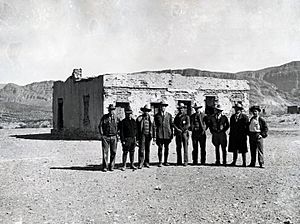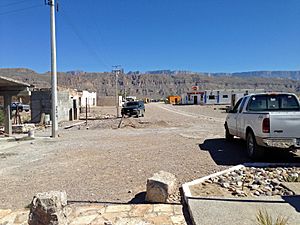Boquillas del Carmen facts for kids
Quick facts for kids
Boquillas del Carmen
(Boquillas)
|
|
|---|---|

View of Boquillas from Big Bend National Park
|
|
| Country | |
| State | Coahuila |
| Municipality | Ocampo |
| Founded | 1890s |
| Elevation | 564 m (1,850 ft) |
| Population
(2020)
|
|
| • Total | 202 |
| Time zone | UTC-6 (Central Time Zone) |
| • Summer (DST) | UTC-5 (Central Daylight Time) |
Boquillas del Carmen, often called just Boquillas, is a small village in northern Mexico. It sits right on the banks of the Rio Grande river. This village is the northernmost town in the Ocampo area of the Mexican state of Coahuila.
Boquillas del Carmen is located near the Sierra del Carmen mountains and at the end of the Rio Grande's Boquillas Canyon. It started as a mining town in the late 1800s when valuable minerals were found nearby. However, mining stopped in 1919, and many people moved away.
The village is right next to the Mexico–United States border. Visitors from the United States can walk into Boquillas through the Boquillas Port of Entry. Since it's so close to Big Bend National Park, tourism is the main way people in Boquillas make a living. After a major event in 2001, the United States closed the border. This closure greatly hurt Boquillas's economy, and its population dropped by almost half. In 2013, the border reopened, and the town began to recover. The crossing was closed again from 2020 to 2021 because of the COVID-19 pandemic.
Contents
History of Boquillas
Early Days: 1800s
In the early 1890s, people found silver in the Sierra del Carmen mountains. This discovery brought miners to the area. Two mining camps were set up on both sides of the Rio Grande: one in Texas (now Rio Grande Village) and the other in Boquillas del Carmen. Besides silver, miners also found lead and zinc.
The mined metals were first melted down in a small furnace near Boquillas del Carmen. Then, they were taken by road to El Paso for more processing. The mining company even used a cable car to move things across the Rio Grande between the two towns. When mining was at its busiest, between 2,000 and 4,000 people lived in Boquillas del Carmen.
The 1900s and Changes
Around the year 1900, about 2,000 people lived in Boquillas. Most jobs were related to mining lead, silver, and fluorite. But mining stopped in 1919, and the town's population quickly became much smaller.
In the 1930s, there were ideas to create a special International Peace Park. This park would connect Big Bend National Park in the U.S. with the Maderas del Carmen in Mexico. Boquillas del Carmen would have been right in the middle of this big park. However, this plan never fully happened.
Even without the peace park, Boquillas del Carmen still connected with Big Bend. Tourism from across the Rio Grande became the main way people made money. A famous country music singer, Robert Earl Keen, visited Boquillas often. His 1994 album Gringo Honeymoon has a song about his visit to the village. By the year 2000, the town had 191 people.
Boquillas in the 2000s
A big event on September 11, 2001, changed life in Boquillas del Carmen a lot. In May 2002, the border crossing from Big Bend National Park to Boquillas was closed. This closure lasted for a long time. By October 2006, only about 90 to 100 people (19 families) were left in Boquillas. Most residents had to move away because their main source of income, tourism, was gone. By the 2010 census, only 110 people lived there.
On January 7, 2011, the U.S. National Park Service announced plans to reopen the crossing. They planned to use a ferry and a passport control center. After some delays, the new Boquillas Port of Entry officially opened on April 10, 2013. The U.S. Secretary of the Interior at the time, Ken Salazar, helped a lot to get the border crossing reopened.
Today, the crossing is open from 9 a.m. to 6 p.m., Wednesday through Sunday. These hours can change with the seasons. Since the border reopened, Boquillas del Carmen has grown. It now has electricity from solar panels, a new medical office, and improvements at the public elementary school. Visitors can bring one bottle of alcohol back to the U.S. through this crossing, but not tobacco.
The U.S. authorities closed the Boquillas Port of Entry again on March 17, 2020, because of the COVID-19 pandemic. It reopened in November 2021.
How Boquillas Makes Money
After mining stopped, tourism became very important for Boquillas in the 1900s. Jose Falcon's restaurant opened in 1973. In the late 1990s, Boquillas was a small town of about 300 people. They mostly relied on tourists from Big Bend who crossed the Rio Grande to visit the village's bar, restaurant, and taco stands. Children would sell rocks they found in the desert or nearby caves. Tourists could also rent ponys and donkeys, get drinks at Park Bar, or stay overnight at a local bed and breakfast.
Today, the village still earns money from tourists who visit on foot. In 2018, over 11,000 people entered Boquillas from the United States. Local guides offer tours of the village, and you can buy handmade crafts. You can also take tours to the Boquillas Canyon, hot springs, old archaeological sites, and caves. These tours can be by foot, truck, horse/burro, or canoe.
The village has at least two restaurants/bars and several shops that sell crafts made from beads.
There is also a firefighting team called Los Diablos (The Devils) who live in Boquillas. They work in the national park, fighting wildfires. Sometimes, they even help with firefighting efforts in the United States.
Village Life and Services
In 2015, a solar farm started working, bringing electricity to the whole village.
Besides the river crossing to Big Bend, you can reach Boquillas by road using Mexican Federal Highway 53. The nearest larger town is Santa Rosa de Múzquiz. It's about 150 miles (240 km) away, and the trip takes at least 4 hours because the road is not in good condition.
In 2013, there was no cell phone service or internet in Boquillas. Now, there is one telephone line in the village. If you call that line, an operator will tell you when to call back. They will then find the person you want to talk to and make sure they are by the phone for your call.
People of Boquillas
| Historical population | ||
|---|---|---|
| Year | Pop. | ±% |
| 1990 | 187 | — |
| 2000 | 191 | +2.1% |
| 2010 | 110 | −42.4% |
| 2020 | 202 | +83.6% |
| Source: XI Censo General de Población y Vivienda 1990, XII Censo General de Población y Vivienda 2000, Censo de Población y Vivienda 2010, Censo de Población y Vivienda 2020 | ||
From 1990 to 2010, the official population of Boquillas was never more than 200 people. It even dropped by over 40% during that time. By 2017, it was thought that about 300 people lived there. However, the official census in 2020 recorded a smaller growth, with 202 people living in the village.
The village has a Roman Catholic church and a small Baptist church. In 2020, most people in Boquillas were either Protestant/Evangelical (42%) or Roman Catholic (37%). About 21% of people reported having no religion.
Climate and Weather
| Weather chart for Boquillas del Carmen | |||||||||||||||||||||||||||||||||||||||||||||||
|---|---|---|---|---|---|---|---|---|---|---|---|---|---|---|---|---|---|---|---|---|---|---|---|---|---|---|---|---|---|---|---|---|---|---|---|---|---|---|---|---|---|---|---|---|---|---|---|
| J | F | M | A | M | J | J | A | S | O | N | D | ||||||||||||||||||||||||||||||||||||
|
15
18
6
|
15
20
5
|
13
30
13
|
14
37
17
|
42
41
21
|
48
44
24
|
58
40
23
|
44
40
23
|
124
37
21
|
35
33
17
|
40
25
13
|
6
19
8
|
||||||||||||||||||||||||||||||||||||
| temperatures in °C precipitation totals in mm |
|||||||||||||||||||||||||||||||||||||||||||||||
|
Imperial conversion
|
|||||||||||||||||||||||||||||||||||||||||||||||
See also
 In Spanish: Boquillas del Carmen para niños
In Spanish: Boquillas del Carmen para niños



